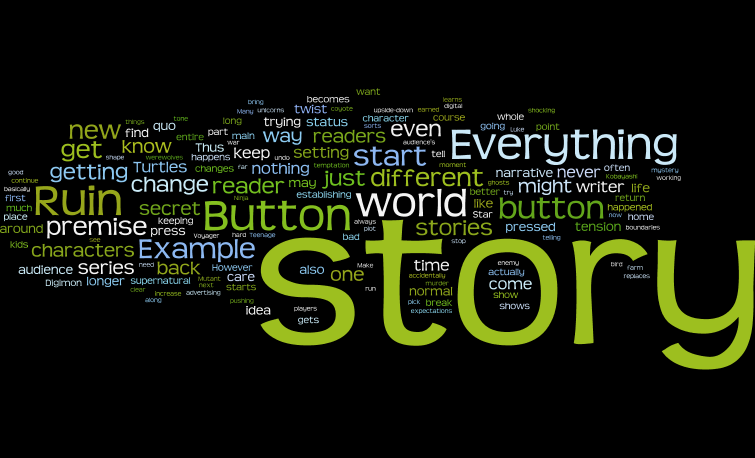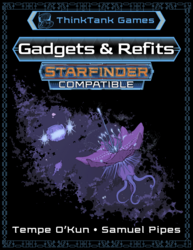Sign In
CloseThe "Ruin Everything" Button: How To Make Your Story Self-Destruct by Tempo (critique requested)
The "Ruin Everything" Button: How To Make Your Story Self-Destruct
by Tempe O'Kun and Slate
~ ~ ~
~ Introduction ~
Many perfectly good stories have a button which, if pressed, will ruin everything. This narrative twist not only changes the status quo—it replaces the whole premise of the story. Readers will resent this. This is not to say that you can never have a "point of no return" in your story. You just need to be cognizant about what you're doing.
The trouble with ongoing stories is that they keep going on. Thus, the temptation exists to write in a shocking twist, in the hope of keeping both reader and writer from getting too bored to continue. In the short term, this often has the desired effect. The audience wonders how the story could possibly return to the original parameters; little do they know it can't. Then they are bummed out, because the story they liked has stopped happening and been replaced by some other story.
The constraints on your narrative (the Things That Must Not Happen) are what give your story shape and structure. Without them, the story becomes an amoeba, formless and without direction. That's the trap. That's the Ruin Everything Button.
~ Exactly what is the Ruin Everything Button? ~
At the beginning of your story, when you're establishing the scope and scale of the narrative, you are also establishing its boundaries. Some of these boundaries are basically universal, like "The story can't continue if all the characters are dead." Others will emerge as logical extensions of your premise: If your story is about a badass who wanders the land fighting ghosts, you are promising the reader danger, travel and the supernatural. A storyline that removes any of these elements from play, such as finding a way to befriend the ghosts or trapping your protagonist in a single location, will drastically alter the types of stories you can tell. Important lore might no longer be relevant. Beloved characters might have nothing to do. Worst of all, readers won't be getting what they signed on for. You didn’t mean to do it, but you’ve pressed the Ruin Everything Button.
An author presses the Ruin Everything Button when, in an attempt to expand the world or raise the stakes of a story, they accidentally break something fundamental that renders the initial premise untenable.
Every time you sit down to brainstorm a new plotline, the Ruin Everything Button will be there, tempting you. As the length of a story increases, therefore, the odds of the author giving in to temptation can only increase. In a professional environment, the added pressure of deadlines or editorial demands may accelerate the process. It becomes increasingly tempting to press the button in longer stories, because it's always there when you try to come up with the next story idea. However, it never actually stops being a bad idea (unless you're trying to end the story).
Example: Miss Kobayashi's Dragon Maid
The human world thinks dragons aren't real, but Kobayashi has a huge one living with her as her maid. Since the story is all about their amusing antics at home, the rest of the world can never find out that Tohru is a dragon. This would result in the status quo ending and a new story starting, since it would be impossible for Kobayashi to have a terrible office job if the world knew she lived with an actual dragon. Thus, the audience would no longer be getting what they signed up for: a relatable story about modern life, but with a fantasy twist.
Example: The Last Unicorn
The entire story centers around finding out what happened to the other unicorns and getting them back. We can have all sorts of adventures along the way—but once the eponymous unicorn stops being the last, the story is over. Thus, all the cool stuff has to happen before that point. This is why we don't meet any of the other unicorns. The story starts winding down the moment they are set free, so we don't have time to get to know them.
~ How can I spot the Ruin Everything Button? ~
It can be identified by the following criteria:
1) An idea around which the premise or tension of the story is built.
2) If the button is pressed, it changes the story into something unrecognizable.
The button is obvious to the reader and writer from the start. It may seem like a way to increase the tension. Unfortunately, it just replaces the stakes we've come to understand and care about with entirely new ones.
The existence of the button isn't itself bad. However, it may be a limiting factor on how many stories you can tell with that setup before it strains believability. Star-crossed lovers can only have so many stolen moments together before we start to think their families must be too stupid to notice. The superhero can only dash off to don his cape a limited number of times before his friends start to wonder why he's never around to see the action.
Example: Teenage Mutant Ninja Turtles
The Turtles start out fighting muggers and rival ninjas. That's fun, but eventually a writer starts to run out of street-level storylines and struggles to maintain tension because the Turtles are so much more powerful than most foes they face, especially on their home turf. So the writer introduces other outlandish creatures and phenomena. Before long, the Turtles are in outer space using teleportation swords to fight demons. That's jarring. It feels like a totally different story than the one the viewer sat down for. That said, 2018's Rise of the Teenage Mutant Ninja Turtles gets around this by having the magic and monsters show up from the start.
Example: Wile E. Coyote and The Road Runner
The coyote wants to eat the bird. But if he eats the bird, the story is over. A deeper look into the cartoon shows us that the fun comes from the coyote setting himself up for failure and/or refusing to abandon a flawed plan.
Example: Werewolf: The Apocalypse
In this RPG, werewolves and other supernatural beings don't agree on much, but they all agree they need to hide their existence from humanity, lest they be hunted down by the far more numerous humans. This conceit is a source of tension in the stories. It also allows for the setting to resemble our world, but with a secret supernatural world just under the surface. That means players know how to act and what to expect. If we press the Ruin Everything Button and make it so werewolves are common knowledge, what happens? The story changes from a handful of supernaturals interacting with each other in the shadows to the entire planet being thrown into chaos. All the work the characters invested in staying secret seems pointless in retrospect. The world at large becomes radically different from our own, leaving the players unsure what assumptions they can make.
~ What isn't the Ruin Everything Button? ~
In some cases, an event that appears to be hitting the button is actually a normal part of the story. These include:
• The change happens very early in the story, as we're shown first the "normal" world and then the way it gets turned upside-down so the story can start. TMNT 2018, as mentioned above, takes this even further—it doesn't even bother to show us a normal world!
• The change happens at or after the climax of the story, tying up the narrative. (A future story can pick up where the world-changing event left off, but it will be quite different.)
• The change has been "earned." If we've come to care about and root for the POV character, then find out she accidentally committed the murder in question, we'll be on board for that twist. The story can transform from a "who done it?" to a "how can she get away with it?" So long as the writer has earned the change in tone by getting us on her side, we'll be along for the ride.
Example: Digimon Adventure
The first episode of the show turns the world upside-down: regular kids are living normal lives and then they get pulled into a digital world and befriend digital monsters. This is not the Ruin Everything Button. Instead, it's just part of the inciting incident that gets the story moving. It's central to the premise. The kids never being able to see their Digimon again is the Ruin Everything Button—the story wouldn't be recognizable if that happened. The creators are savvy enough to keep the Digimon in the shows.
~ Isn't keeping things unpredictable good? ~
You have to keep your promises. If the reader has no anchor to hold onto, if everything can change on a dime, they won't be able to bring themselves to care. Sometimes this is about managing the audience's expectations beforehand: Imagine a version of Star Wars where we didn't follow the droids through that opening battle, and the story instead spent that time getting us invested in Luke's life working a farm in the middle of nowhere, getting to know the locals, establishing that the main conflict of the story was going to be Luke trying to earn his way off the farm. There would be nothing to indicate that the fate of the galaxy was at stake in this story, and having his family get murdered and him taking off to go blow up a doomsday weapon would have been incredibly jarring.
If you find yourself struggling to come up with ideas that don't involve blowing up your setting, it may be time to consider that your story has run its course. There's nothing wrong with ending a story. You can even return to those characters for a new story, under a different premise. In the above example, Luke shows up after he has his main arc in Episodes IV-VI, but in a different role—he's now the mentor, not the newbie. It's a new story.
~ Can we undo pushing the button? ~
You can, but it's often unsatisfying. Many retcons and "it was all a dream" twists stem from the desire to push the button and then undo it. However, audiences have a limited amount of patience for fake-outs and take-backs. If you yank their chain too often, they will stop caring about the story.
If you're going to press the button, press it hard. Commit to the change. Embrace that the story as you've been telling it is over.
The worst thing you can do now is backpedal and try to restore the previous status quo. In doing so you telegraph to your audience that the threat you've been telling them to worry about is actually completely toothless.
If you kill off a character, then bring her back to life, it weakens the whole affair because death is no longer a hazard. The better idea is to avoid pushing the button. Killing a character, even an important one, isn't nearly as dangerous to the audience's immersion as bringing them back to life and trying to pretend nothing happened. If everyone who learns your superhero's secret identity suffers a convenient head wound and forgets what they saw, no one will care the next time the secret is threatened.
Of course, you can start a follow-up story in the same setting. Or a prequel. Or a parallel story. (Or a reboot. This is one of the reasons reboots are so common. You get to start over with a formula you know works.) A change of title might be called for, or the addition of a subtitle. Make it clear you know what you're doing, that you're aware of the break in the story you've created. You can certainly tell readers it's in the same setting, but making a clear break resets the expectations.
Example: Star Trek: Voyager
The crew of Voyager trying to get back to the Federation is the overarching plot of the entire series. Thus, once they get home, this particular story is over. Of course, we can have more Star Trek. We can even have the characters come back. But after the Ruin Everything Button has been pressed, any further adventures are a new story or series.
~ So it's always bad? ~
There are no hard and fast rules in art, and even the Ruin Everything Button can be an effective storytelling tool. One place where it thrives is in a grand finale. What better way to assure the audience that nothing will be the same than by destroying the things that held the status quo in place?
Example: Animorphs
The Animorphs spent fifty books in a secret war where the enemy learning their identities would spell certain doom, so naturally in the final part, the enemy learns their names and forces them to turn the whole world upside down just to survive. Then the series ends. That's because the premise was that these are kids like the reader (except they have cool powers and secret missions). The characters would stop being as relatable if the series continued far beyond this point.
Example: Avatar: The Last Airbender
The series is all about defeating the Fire Lord and stopping an ongoing war. As soon as that threat is removed, the story is basically over. You might have some plot threads to tie up, but the main driving force is gone. That is why the follow-up series felt so different—it was a new story with a new premise, in a world irrevocably changed by the events of the previous story.
~ Conclusion ~
Really, the Ruin Everything Button is one aspect of knowing the shape of your story. Think about what kind of story you are advertising to readers. What does it say on the box? If the story starts as a gritty, suspenseful mystery, that's what it should deliver on. If the story presents itself as a lighthearted slice-of-life story, that's what it should stay because that's what the reader chose when they picked it up. That's what they want. You don't get credit for delivering a newspaper if the reader ordered a pizza.
The internet equivalent of this is "tag your work"—the notion that just about anything is acceptable material for a story, but it should be advertised up front. Not only does that keep readers from abandoning a story midway through because they sour on it, it also helps them find it in the first place.
We all read different sorts of stories. We pick them based on not just our lasting interests, but also our mood at the moment. If you've had a long day, you might want a cute and simple comedy. That said, you might want a tense and intricate murder mystery when you have the brainpower for it. Recognize the sort of story you're advertising and deliver on that. You can surprise readers, but do so within the limits of your unspoken agreement with them. A suspense thriller has much more room for double-crosses and shocking deaths than a sappy love story. By keeping in mind the tone and genre you're working with from the start, you can better satisfy your readers and keep them coming back for more—even if it's different.
Submission Information
- Views:
- 256
- Comments:
- 0
- Favorites:
- 0
- Rating:
- General
- Category:
- Visual / Other




